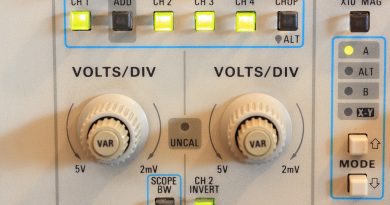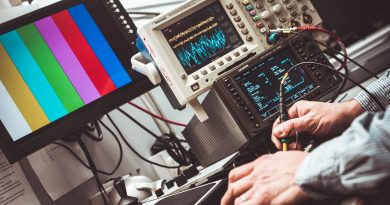CALCULATING PHASE SHIFT WITH AN OSCILLOSCOPE
Electronic circuits will inevitably delay signals and, although it’s not always a bad thing, shift the phase of the signal. The amount of phase shift will be different for various circuits as a result of their unique designs. One thing you can do is choose a circuit design with minimal phase shift and then visually measure the phase shift with an oscilloscope. You can calculate the phase shift by measuring the circuit’s input signal with your oscilloscope’s first channel and the circuit’s output with your scope’s second channel.
First off connect a BNC T-connector to the sine wave oscillator’s output, which will essentially give your oscillator two outputs. Connect a BNC cable from one end of the T-connector to the channel one input on your scope. Then connect another BNC cable from the other end of the T-connector to the input of the circuit you’re testing and attach an oscilloscope probe to the channel two input, connecting the probe to the circuit’s output.
Turn on the oscillator, circuit, and oscilloscope and adjust the oscillator until its frequency and amplitude come into the circuit’s operating range. Be careful not to overdrive the circuit with the oscillator.
Turn your oscilloscope’s horizontal sweep rate control until you eventually observe two or three sine wave cycles on your scope’s display, and then adjust the vertical position and sensitivity until you can see sine waves on both channels (channel one on top and channel two on the bottom). Set your oscilloscope’s sweep trigger to channel one to steady the sine wave if necessary.
Find a peak on the channel one sine wave. Follow that point down to the horizontal time-division marks in the oscilloscope’s display’s center. Then find the corresponding peak on channel two and its time-division mark. Count the major divisions between the time-division marks for channel one and two (including any fractions of a division) — this is the phase shift of your two signals.
Check the top sine wave again and count the major divisions for an entire cycle (including fractions again). You’ll then want to divide the difference between the signals for channels one and two by the divisions for an entire cycle, and multiply two time pi to find the phase shift in radians. Multiply by three hundred sixty instead of two times pi to get the phase shift in degrees.
(Note: Some digital storage oscilloscopes are able to measure and calculate the time difference between to points on the display automatically. In this case you would select the time measurement function and situate two vertical cursors at the starting and ending points for the interval you want to calculate. The oscilloscope will then display the time difference.)

